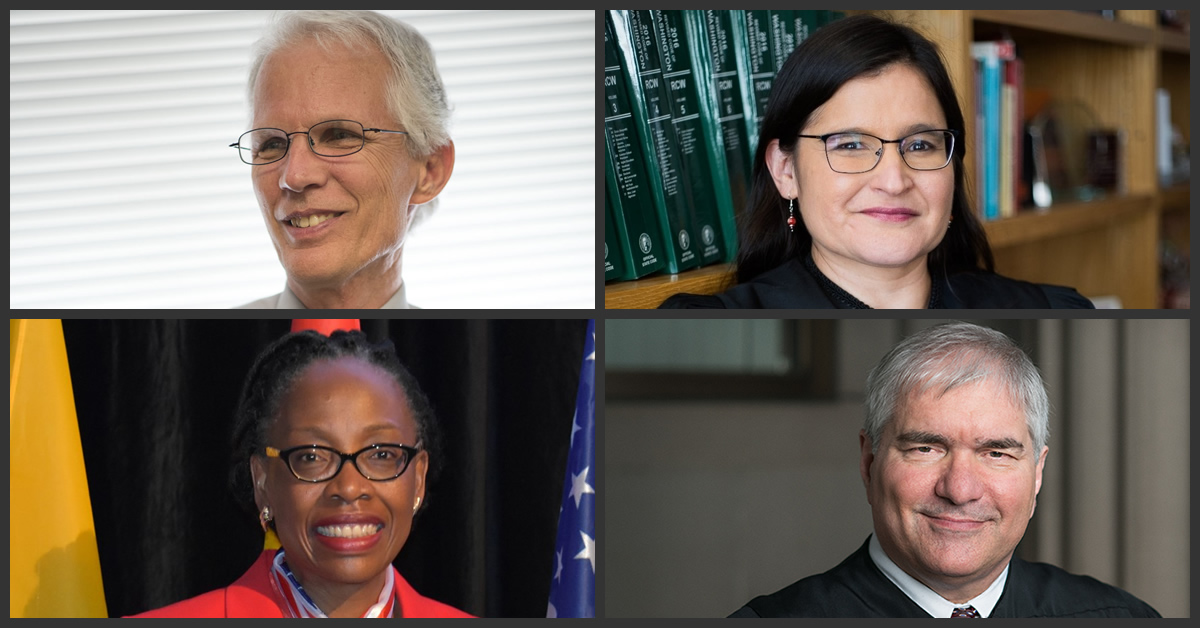Around four out of five likely 2020 Washington voters are unsure who they’ll be supporting in this year’s contested State Supreme Court races, the Northwest Progressive Institute’s latest statewide poll has found.
Asked whether they would vote for incumbents G. Helen Whitener (for Position #6) and Raquel Montoya-Lewis (for Position #3), or their challengers Richard Serns and David Larson, the vast majority of respondents said they were not sure. The figure of undecided voters was 81% for the race for Position #6 (Whitener vs. Serns) and 78% for Position #3 (Montoya-Lewis vs. Larson).
13% of respondents indicated a preference for Justice Whitener for Position #6 and 6% indicated a preference for Whitener’s opponent, Serns.
14% of respondents indicated a preference for Justice Montoya-Lewis for Position #3 and 8% indicated a preference for Montoya-Lewis’ opponent Larson.
Our survey of 1,070 likely 2020 Washington State voters was in the field from Tuesday, May 19th through Wednesday, May 20th, 2020.
It utilizes a blended methodology, with automated phone calls to landlines and text message answers from cell phone only respondents.
The poll was conducted by Public Policy Polling for the Northwest Progressive Institute, and has a margin of error of +/- 3.0% at the 95% confidence level.
The full text of our question in the race for Position #3 and the answers were:
QUESTION: The candidates for Washington State Supreme Court Position #3 this year are David Larson and Raquel Montoya-Lewis. If the election were held today, who would you vote for?
ANSWERS:
- David Larson: 8%
- Raquel Montoya-Lewis: 14%
- Not sure: 78%
And for Position #6:
QUESTION: The candidates for Washington State Supreme Court Position #6 this year are G. Helen Whitener and Richard S. Serns. If the election were held today, who would you vote for?
ANSWERS:
- G. Helen Whitener: 13%
- Richard S. Serns: 6%
- Not sure: 81%
The results for these races are similar to NPI’s 2018 State Supreme Court finding from two years ago, when we asked likely voters whether they preferred the exceptionally well qualified Justice Steven Gonzalez or his opponent, conspiracy theorist Nathan Choi. In that survey, 74% of voters said they were not sure, while 16% preferred Choi and only 10% preferred Gonzalez.
At the time we released our 2018 finding, we expressed our deep concern that voters might open up their ballots without having heard much about the candidates. We asked other media outlets to step up and join us in covering the race. Several reporters responded and rose to the occasion, notably public radio’s Austin Jenkins and KIRO7’s Essex Porter. Their reporting that autumn was instrumental in helping Washingtonians make an informed decision.
Justice Gonzalez ultimately received 67.58% of the vote in the November general election, winning reelection in a landslide and carrying every county in the state.
The result was a validation of the importance of elemental political reporting.
As judicial candidates, Choi and Gonzalez appeared on the ballot with no party designation or other information provided, making it hard for anyone without a firm grasp of Washington State politics to easily tell them apart.
Contests for executive and legislative positions in Washington are typically partisan, whether at the state or county level, but all judicial positions are nonpartisan. What’s more, judicial candidates are restricted in terms of how they may campaign by the Code of Judicial Conduct.
A judge or justice may be well known to members of the bar, but the same does not hold true for the general public. This lack of awareness in judicial elections is a recurring issue that we have to deal with every year, for Washington voters are tasked with deciding who should sit on the bench at multiple levels… municipal court, district court, Superior Court, Court of Appeals, and Supreme Court.
Justices Whitener and Montoya-Lewis ended up on the Supreme Court through the process of appointment; the departure of their predecessors mid-term created vacancies that Governor Jay Inslee had the responsibility of filling, and his office took that responsibility extremely seriously. However, it’s the voters who will decide who ought to serve on the Court over the long haul.
Full terms on the Washington State Supreme Court are for six years, so the result of a Supreme Court race is pretty consequential.
A grand total of four seats on the Court are up for election this year.
Incumbent Justices Debra Stephens (currently the Chief Justice) and Charles W. Johnson did not draw any challengers, so they will remain in office.
That leaves two contested positions: the aforementioned races between Whitener and Serns and between Montoya-Lewis and Larson.
It’s crucial that voters know who these candidates are and what their qualifications are so they can make an informed decision this fall.
Washington State’s media outlets are among the few organizations that are in a position to address the lack of awareness in judicial elections.
By caring about the Supreme Court races, talking to the candidates, and putting together stories for voters’ benefit, publishers in the Evergreen State can provide a critical public service during this historic presidential election year.
We appreciate that this is a tough time for people working in journalism; the pandemic is negatively affecting the work of many newsrooms.
But we’ll all be better off if these races get the coverage they deserve.
We’re committed to doing our part to creating that coverage, and we hope other media organizations will join us. We plan on checking in on these Supreme Court races again this autumn, and hopefully, when our next survey comes back, we will find a smaller number of voters who are not sure as to their choice.
And this summer, you can expect to see a Cascadia Advocate series profiling 2020 judicial candidates, including — but not limited to! — our Supreme Court hopefuls.

